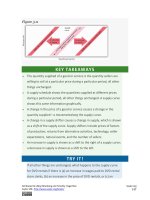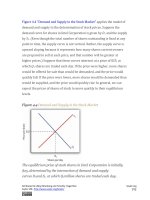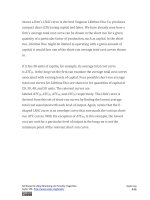Authors libby rittenberg 450
Bạn đang xem bản rút gọn của tài liệu. Xem và tải ngay bản đầy đủ của tài liệu tại đây (523.93 KB, 1 trang )
of output over which diseconomies of scale occur; this phenomenon is one
factor that limits the size of firms. A firm operating on the upward-sloping
part of its LRAC curve is likely to be undercut in the market by smaller
firms operating with lower costs per unit of output.
The Size Distribution of Firms
Economies and diseconomies of scale have a powerful effect on the sizes of
firms that will operate in any market. Suppose firms in a particular
industry experience diseconomies of scale at relatively low levels of
output. That industry will be characterized by a large number of fairly
small firms. The restaurant market appears to be such an industry. Barbers
and beauticians are another example.
If firms in an industry experience economies of scale over a very wide
range of output, firms that expand to take advantage of lower cost will
force out smaller firms that have higher costs. Such industries are likely to
have a few large firms instead of many small ones. In the refrigerator
industry, for example, the size of firm necessary to achieve the lowest
possible cost per unit is large enough to limit the market to only a few
firms. In most cities, economies of scale leave room for only a single
newspaper.
One factor that can limit the achievement of economies of scale is the
demand facing an individual firm. The scale of output required to achieve
the lowest unit costs possible may require sales that exceed the demand
facing a firm. A grocery store, for example, could minimize unit costs with a
large store and a large volume of sales. But the demand for groceries in a
small, isolated community may not be able to sustain such a volume of
Attributed to Libby Rittenberg and Timothy Tregarthen
Saylor URL: />
Saylor.org
450









